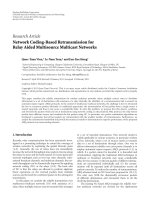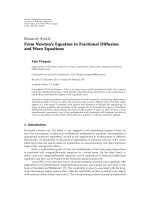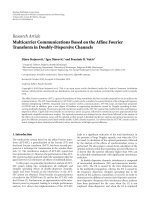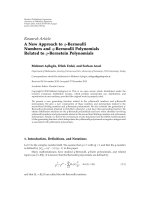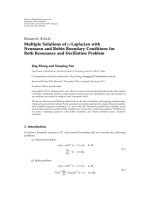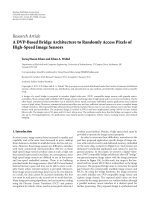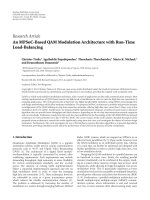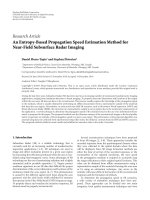Báo cáo hóa học: "Research Article Z-Complementary Sets Based on Sequences with Periodic and Aperiodic Zero Correlation Zone" pptx
Bạn đang xem bản rút gọn của tài liệu. Xem và tải ngay bản đầy đủ của tài liệu tại đây (657.98 KB, 8 trang )
Hindawi Publishing Corporation
EURASIP Journal on Wireless Communications and Networking
Volume 2009, Article ID 418026, 9 pages
doi:10.1155/2009/418026
Research Article
Z-Complementary Sets Based on Sequences with Periodic and
Aperiodic Zero Correlation Zone
Zhenyu Zhang,
1, 2
Wei Chen,
1
Fanxin Zeng,
2
Hua Wu,
1
and Yuanhong Zhong
1
1
College of Communication Engineering, Chongqing University, Shazheng Street no. 174, District of Shapingba,
Chongqing 400044, China
2
Department of Information Engineering, Chongqing Communication Institute, Linyuan no. 1, District of Shapingba,
Chongqing 400035, China
Correspondence should be addressed to Zhenyu Zhang,
Received 18 September 2008; Revised 23 December 2008; Accepted 10 February 2009
Recommended by Ibrahim Develi
Methods of constructing Z-complementary sequence sets are described. Different from those constructions using complementary
sequences as a kernel, the proposed constructions are based on sequences with periodic and aperiodic zero-correlation zone
(PAZCZ). These PAZCZ sequences are unitary sequences, not complementary sequences. By means of interleaving iteration and
orthogonal matrix expansion of PAZCZ sequences, desirable bivalued zero cross-correlation zone (ZCCZ) characteristics can be
obtained. Compared with Z-complementary sequence sets with single value ZCCZ which is generally equal to the length of an
element sequence, the proposed Z-complementary sequence sets with bivalued ZCCZ have larger set size and then can support
more users.
Copyright © 2009 Zhenyu Zhang et al. This is an open access article distributed under the Creative Commons Attribution License,
which permits unrestricted use, distribution, and reproduction in any medium, provided the original work is properly cited.
1. Introduction
Complementary sequences, first studied by Golay [1],
have many useful properties for radar applications and
spread-spectrum communications. Different from unitary
sequences which work on a one-sequence-per-user basis,
complementary sequences work on a one-flock-per-user
basis [2]. It was shown in [3, 4] that orthogonal comple-
mentary (OC) sequences with ideal autocorrelation function
(ACF) and cross-correlation function (CCF) can improve
spectrum efficiency and bit error rate (BER) performance of
code division multiple access (CDMA) systems.
Although OC sequences have ideal correlation proper-
ties, they cannot support the large number of users since
the set size must not be larger than the flock size [2, 5].
To increase the set size of complementary sequence sets, the
idea of zero-correlation zone (ZCZ) [6–8] or interference-
free windows (IFWs) [9, 10] was exploited to the genera-
tion of complementary sequences, and generalized pairwise
complementary (GPC) sequences [11] with the setwise
uniform IFWs were constructed on the basis of complete
complementary sequences [12] and generalized even shift
orthogonal sequences [13]. Similar to the construction idea
of GPC sequences, generalized pairwise Z-complementary
(GPZ) sequences were generated in [14]. GPZ sequences are
based on generalized even shift orthogonal-like sequences
and include GPC sequences as a special case.
Compared with GPC and GPZ sequences which limit the
flock size to be two, Z-complementary binary sequences [15]
have fewer restrictions on the flock size. As a more general
concept, Z-complementary sequences include the conven-
tional complementary sequences as special cases. These
sequences can efficiently resolve the limits on the lengths of
conventional complementary sequences, and the theoretical
bound given by [15] shows that Z-complementary sequences
have much larger set size than conventional complementary
sequences. In terms of the set of Z-complementary mates
generated in [15], the zero cross-correlation zone (ZCCZ)
is equal to the length of element sequences, and is usually
larger than the zero autocorrelation zone (ZACZ) except that
Z-complementary sequences become conventional comple-
mentary sequences.
Different from Z-complementary sequences with single
value ZCCZ, intergroup complementary (IGC) sequences
2 EURASIP Journal on Wireless Communications and Networking
[16] possess a bivalued ZCCZ. The IGC sequence set is
divided into several sequence groups. CCFs of any two
sequences from the same group are zero within an intragroup
IFW, while CCFs of any two sequences from different groups
are zero everywhere. According to the theoretical bound
in [15], the set size of IGC sequences comes up to the
maximum number. However, just like other complemen-
tary sequences, IGC sequences still use a complementary
sequence set as a basic kernel, which limits the employment
of unitary sequences in the construction of complementary
sequences.
Actually, the idea of dividing a sequence set into multiple
groups and hence obtaining bivalued ZCCZ first appears
in [17] as mutually orthogonal sets of ZCZ sequences.
Each of these sets is a ZCZ set, and any two sets are
mutually orthogonal, which increases the number of avail-
able sequences for CDMA systems. Mutually orthogonal
sets of ZCZ sequences can also be constructed in a new
framework for constructing mutually orthogonal comple-
mentary sets and ZCZ sequences [18]. The framework
involved characteristic matrices and mutually orthogonal
Golay complementary sets (MOGCSs), and the required
complete MOGCS in the framework was further studied on
the basis of Reed-Muller codes in [19]. In comparison with
MOGCS, GPC, Z-complementary sequences, IGC, and GPZ,
it can be seen that mutually orthogonal sets of ZCZ sequences
are unitary sequence sets, not complementary sequence
sets.
This paper proposes methods to construct Z-
complementary sets based on a set of sequences with
PAZCZ which is a set of unitary sequences. By means of
orthogonal matrix expansion and interleaving operation,
two novel sets of Z-complementary sequences can be
generated from a basic kernel of a PAZCZ sequence set.
As an extension for Z-complementary sequences with
single value ZCCZ in [15], the presented Z-complementary
sequences have a bivalued ZCCZ like IGC sequences and
can come up to the maximal set size as long as the kernel of
PAZCZ sequences comes up to the maximal set size in terms
of the theoretical bound on ZCZ sequences in [20].
The paper is organized as follows. In Section 2,we
briefly introduce the definitions and notations used in the
present paper. By using a PAZCZ sequence set as a basic
kernel, Sections 3 and 4 present two construction schemes
of Z-complementary sequences on the basis of orthogonal
matrix expansion and interleaving operation, respectively.
Some potential applications of the proposed sequence sets
are described in Section 5, and we conclude the paper in
Section 6.
2. Preliminary Considerations
Z-complementary sequences generally have larger set size
than normal complementary sequences at the expense of
correlation properties. Actually, a Z-complementary set
can be considered to be a trade-off between correlation
properties and set size. Although ideal correlation properties
cannot be obtained, the CCFs and out-of-phase ACFs of Z-
complementary sequences are zero within a region around
the zero shift. Z-complementary sequences can be defined as
follows.
Let A be a flock of complex-valued sequences with N ele-
ment sequences of length L,writtenasA
={A
i
,1 ≤ i ≤ N}
with each element sequence A
i
= (A
i
(0), A
i
(1), , A
i
(L −
1)). Then A ={A
i
,1 ≤ i ≤ N} is a Z-complementary
sequence with flock size N if the sum Ψ
A,A
(τ) of the aperiodic
out-of-phase ACFs of N element sequences are zero within a
region, namely,
Ψ
A,A
(τ) =
N
i=1
ψ
A
i
,A
i
(τ) =
⎧
⎪
⎪
⎨
⎪
⎪
⎩
N
i=1
E
A
i
, τ = 0,
0, 1
≤|τ|≤Z −1,
(1)
where ψ
A
i
,A
i
(τ) is the aperiodic ACF of element sequence A
i
.
The notations Z and E
A
i
denote the length of ZCZ and the
energy of element sequence A
i
,respectively.
Let B
={B
i
,1 ≤ i ≤ N} be another Z-
complementary sequence with each element sequence B
i
=
(B
i
(0), B
i
(1), , B
i
(L − 1)). Then B ={B
i
,1 ≤ i ≤ N} is
referred to as a Z-complementary mate of A
={A
i
,1 ≤ i ≤
N}if
Ψ
A,B
(τ) =
N
i=1
ψ
A
i
,B
i
(τ) = 0, |τ|≤Z −1, (2)
where Ψ
A,B
(τ) represents the sum of the aperiodic CCFs of N
element sequences of A and B. ψ
A
i
,B
i
(τ) denotes the aperiodic
CCF of A
i
and B
i
, and is given by
ψ
A
i
,B
i
(τ) =
⎧
⎪
⎪
⎪
⎪
⎪
⎪
⎪
⎪
⎪
⎪
⎪
⎨
⎪
⎪
⎪
⎪
⎪
⎪
⎪
⎪
⎪
⎪
⎪
⎩
L−1−τ
l=0
A
i
(l)B
∗
i
(l + τ), 0 ≤ τ ≤ L −1,
L−1+τ
l=0
A
i
(l − τ)B
∗
i
(l), 1 −L ≤ τ<0,
0,
|τ|≥L,
(3)
where the symbol
∗
denotes a complex conjugate. When A
i
=
B
i
, the above definition becomes aperiodic ACF ψ
A
i
,A
i
(τ).
In addition to aperiodic correlation properties, periodic
correlation properties are also important for system per-
formance and should be analyzed as GPC, GPZ, and IGC
sequences do. For two element sequences of A
i
and B
i
, their
periodic CCF can be expressed as
φ
A
i
,B
i
(τ) =
L−1
l=0
A
i
(l)B
∗
i
(l + τ), 0 ≤ τ ≤ L −1, (4)
where l + τ is performed modulo L. When A
i
= B
i
, the above
definition becomes periodic ACF of A
i
.
If any Z-complementary sequence in a set contain-
ing M Z-complementary sequences is a mate of other
Z-complementary sequences in this set, then these Z-
complementary sequences compose a Z-complementary set
EURASIP Journal on Wireless Communications and Networking 3
with set size M.Intermsof[15], the set size M is bounded
by
M
≤ N
L
Z
,(5)
where
L/Z denotes the largest integer smaller than or equal
to L/Z.
From (5), a Z-complementary set generally has larger
set size than a conventional complementary set even if
the conventional complementary set is complete. However,
for the fixed processing gain and the length of ZCZ, the
set size of a Z-complementary set is smaller than that of
mutually orthogonal ZCZ sequence sets in [17–19] and is
usually comparable to the set size of each set of mutually
orthogonal ZCZ sequence sets without regard to correlation
properties.
When a Z-complementary set is divided into several
sequence groups, the set will have the bivalued ZCCZ
characteristics like IGC sequences. We assume that a Z-
complementary set with set size M,flocksizeN,element
sequence length L,andZCZlengthZ, contains G sequence
groups, then the Z-complementary set can be denoted by
Z-CS(M, N,L, G, Z).
According to the definition of Z-complementary seq-
uences, a Z-complementary set becomes a conventional
complementary set when Z
= L,andbecomesaPAZCZ
set when N
= 1 in terms of the definition of PAZCZ
sequences in [21, 22]. Then Z-complementary sequences
include the conventional complementary sequences and
PAZCZ sequences as special cases.
3. Sequence Construction Based on
Orthogonal Matrix Expansion
A new scheme for the construction of Z-complementary
set is presented in this section. The constructed sequences
have good correlation properties and large set size. To show
the performance of the generated sequences, a construction
exampleisgiven.
3.1. The Construction Scheme. The proposed construction
uses an arbitrary PAZCZ sequence set as a basic kernel. By
means of orthogonal matrix expansion, the bivalued ZCCZ
characteristics can be obtained.
Construction 1. GivenanarbitraryPAZCZsequencesetS
with set size K and sequences length L,let S possess the ZCZ
of one-sided length Z for periodic and aperiodic correlation
functions. Then S can be denoted by Z-(K, L, Z)andbe
arranged in matrix form as follows:
S
=
⎡
⎢
⎢
⎢
⎢
⎣
S
1
S
2
.
.
.
S
K
⎤
⎥
⎥
⎥
⎥
⎦
=
⎡
⎢
⎢
⎢
⎢
⎣
S
1
(0) S
1
(1) ··· S
1
(L −1)
S
2
(0) S
2
(1) ··· S
2
(L −1)
.
.
.
.
.
.
.
.
.
.
.
.
S
K
(0) S
K
(1) ··· S
K
(L −1)
⎤
⎥
⎥
⎥
⎥
⎦
. (6)
Let H be a U
×V orthogonal matrix given by
H
=
⎡
⎢
⎢
⎢
⎢
⎣
h
1,1
h
1,2
··· h
1,V
h
2,1
h
2,2
··· h
2,V
.
.
.
.
.
.
.
.
.
.
.
.
h
U,1
h
U,2
··· h
U,V
⎤
⎥
⎥
⎥
⎥
⎦
,(7)
where any two distinct rows are orthogonal each other, and
U
≤ V (generally U = V). Each entry is a complex number
with unity amplitude. Then
C
= H ⊗S =
⎡
⎢
⎢
⎢
⎢
⎣
h
1,1
Sh
1,2
S ··· h
1,V
S
h
2,1
Sh
2,2
S ··· h
2,V
S
.
.
.
.
.
.
.
.
.
.
.
.
h
U,1
Sh
U,2
S ··· h
U,V
S
⎤
⎥
⎥
⎥
⎥
⎦
,(8)
is a Z-complementary set Z-CS(UK, V, L, U,Z), where the
notation
⊗ denotes Kronecker product.
The set C is divided into U sequence groups. In the
matrix of (8), each row
h
u,1
Sh
u,2
S ··· h
u,V
S
=
⎡
⎢
⎢
⎢
⎢
⎣
h
u,1
S
1
h
u,2
S
1
··· h
u,V
S
1
h
u,1
S
2
h
u,2
S
2
··· h
u,V
S
2
.
.
.
.
.
.
.
.
.
.
.
.
h
u,1
S
K
h
u,2
S
K
··· h
u,V
S
K
⎤
⎥
⎥
⎥
⎥
⎦
,(1≤ u ≤ U)
(9)
becomes a group, and each group consists of K sequences
with each sequence containing V element sequences of
length L. Then the constructed Z-complementary set C
consists of UK Z-complementary sequences, and the ((u
−
1)K + k)th Z-complementary sequence which is also referred
to as the kth Z-complementary sequence in the uth group
can be denoted by C
u,k
={h
u,1
S
k
, , h
u,v
S
k
, , h
u,V
S
k
},
where 1
≤ u ≤ U,1 ≤ v ≤ V,1 ≤ k ≤ K,and
h
u,v
S
k
= (h
u,v
S
k
(0), h
u,v
S
k
(1), , h
u,v
S
k
(L − 1)) denotes the
vth element sequence of C
u,k
.
When U
= V = 1, the above Z-complementary
set becomes the PAZCZ sequence set Z-(K,L, Z).
Therefore, Z-(K, L, Z) is a special case of the constructed
Z-complementary set and can be also denoted by
Z-CS(K,1,L,1,Z).
3.2. Correlation Properties of the Constructed Set. The aperi-
odic and periodic correlation properties of the designed set
C in Construction 1 satisfy the following theorem.
Theorem 1. The generated Z-complementary set C in Con-
struction 1 has bivalued ZCCZ. The ZCCZ of any two sequences
in a group is equal to Z,andtheZCCZofanytwosequences
from different groups is equal to L, that is, sequences from
different g roups are completely complementary. The ZACZ of
the set C is Z.
4 EURASIP Journal on Wireless Communications and Networking
50−5
Shift τ
−1
0
1
Normalized
magnitude
(a)
50−5
Shift τ
−1
0
1
Normalized
magnitude
(b)
50−5
Shift τ
−1
0
1
Normalized
magnitude
(c)
Figure 1: The distribution of aperiodic ACF and CCF values of Z-
complementary set Z-CS(8,2,8,2,2).(a)ACFofZ-complementary
sequence C
1,1
; (b) intragroup CCF of C
1,1
and C
1,2
; (c) intergroup
CCF.
Proof. We first consider aperiodic correlation properties.
Let C
u
1
,k
1
={h
u
1
,1
S
k
1
, h
u
1
,2
S
k
1
, , h
u
1
,V
S
k
1
} and C
u
2
,k
2
=
{
h
u
2
,1
S
k
2
, h
u
2
,2
S
k
2
, , h
u
2
,V
S
k
2
} be any two Z-complementary
sequences of the constructed Z-complementary set C,where
1
≤ u
1
, u
2
≤ U and 1 ≤ k
1
, k
2
≤ K. Then the aperiodic
correlation function of C
u
1
,k
1
and C
u
2
,k
2
is given by
Ψ
C
u
1
,k
1
,C
u
2
,k
2
(τ) =
V
v=1
ψ
h
u
1
,v
S
k
1
,h
u
2
,v
S
k
2
(τ)
= ψ
S
k
1
,S
k
2
(τ) ·
V
v=1
h
u
1
,v
h
∗
u
2
,v
.
(10)
For (10), when u
1
= u
2
and k
1
= k
2
, Ψ
C
u
1
,k
1
,C
u
1
,k
1
(τ)
becomes ACF of
{h
u
1
,1
S
k
1
, h
u
1
,2
S
k
1
, , h
u
1
,V
S
k
1
} and is equal
to V
· ψ
S
k
1
,S
k
1
(τ). Then the ZACZ of set C is the same as one
of the PAZCZ set S and is Z.
When u
1
= u
2
and k
1
/
=k
2
,(10) represents CCF of two
sequences from the same group, namely, intragroup CCF. We
have Ψ
C
u
1
,k
1
,C
u
1
,k
2
(τ) = V · ψ
S
k
1
,S
k
2
(τ). Then the intragroup
ZCCZ of set C is the same as the ZCCZ of the PAZCZ set S
and is Z.
When u
1
/
=u
2
,(10) denotes CCF of two sequences
from different groups, namely, intergroup CCF. Due to the
orthogonality of matrix H,wehave
V
v
=1
h
u
1
,v
h
∗
u
2
,v
= 0, and
then Ψ
C
u
1
,k
1
,C
u
2
,k
2
(τ) = 0.
According to the above analysis, the aperiodic correlation
properties of the constructed sequences satisfy Theorem 1.
Similar to aperiodic correlation properties, periodic correla-
tion properties can be easily analyzed, and the corresponding
proof is omitted.
In terms of Theorem 1, it is obvious that the constructed
Z-complementary sequences have better correlation proper-
ties than unitary sequences, such as m-sequence and gold
sequences. In addition, for the same intragroup ZCCZ,
the Z-complementary set with bivalued ZCCZ has larger
intergroup ZCCZ than mutually orthogonal ZCZ sequence
sets, since the generated Z-complementary set has ideal
intergroup cross-correlation properties while a sequence
from one set of mutually orthogonal ZCZ sequence sets is
usually nonorthogonal to a sequence from another set for
nonzero shifts. Compared with the idea of large ZCZ set with
smaller subsets of larger ZCZ than the original set [18, 19],
the intergroup ZCCZ of the constructed Z-complementary
set with bivalued ZCCZ is usually larger than its intragroup
ZCCZ.
3.3. Set Size of the Constructed Set. We assume that the
PAZCZ sequence set Z-(K,L,Z) has the maximum set size
in terms of the theoretical bound in [20], namely, K
= L/Z.
Then it is obvious that the constructed Z-complementary
set Z-CS(UK, V , L, U, Z) has the maximum set size in terms
of (5)aslongasU
= V, in which case the set size of
Z-CS(UK, V, L, U,Z)isK times large as that of conventional
complete complementary set like complete MOGCS.
3.4. An Example. We use a ternary PAZCZ sequence set
Z-(4, 8, 2) in [22] as a basic kernel which is given by
S
=
⎡
⎢
⎢
⎢
⎣
S
1
S
2
S
3
S
4
⎤
⎥
⎥
⎥
⎦
=
⎡
⎢
⎢
⎢
⎣
0+0+0+0−
0+0+0− 0+
0+0
− 0+0+
0+0
− 0 − 0 −
⎤
⎥
⎥
⎥
⎦
. (11)
Let H be a 2
× 2 Walsh-Hadamard matrix and be
expressed as H
= [
++
+
−
].
According to Construction 1,wecangenerateaZ-
complementary set Z-CS(8,2,8,2,2)asfollows:
C
=
⎡
⎢
⎢
⎢
⎢
⎢
⎢
⎢
⎢
⎢
⎢
⎢
⎢
⎣
C
1,1
C
1,2
C
1,3
C
1,4
C
2,1
C
2,2
C
2,3
C
2,4
⎤
⎥
⎥
⎥
⎥
⎥
⎥
⎥
⎥
⎥
⎥
⎥
⎥
⎦
=
⎡
⎢
⎢
⎢
⎢
⎢
⎢
⎢
⎢
⎢
⎢
⎢
⎢
⎣
0+0+0+0−, 0+0+0+0−
0+0+0−0+, 0 + 0 + 0 − 0+
0+0
−0+0+, 0+0−0+0+
0+0
−0 − 0−,0+0−0 − 0−
0+0+0+0−,0− 0 −0 −0+
0+0+0
−0+, 0 − 0 −0+0−
0+0−0+0+, 0−0+0−0−
0+0−0 − 0−,0− 0+0+0+
⎤
⎥
⎥
⎥
⎥
⎥
⎥
⎥
⎥
⎥
⎥
⎥
⎥
⎦
. (12)
The constructed Z-complementary set C has maximum
set size in terms of (5). Figure 1 shows aperiodic cor-
relation properties of the constructed Z-complementary
EURASIP Journal on Wireless Communications and Networking 5
set Z-CS(8,2,8,2,2). It is obvious that the generated set
has bivalued ZCCZ characteristics. In this example, the
intragroup ZCCZ is 2, and the intergroup ZCCZ is 8.
4. Sequence Construction Based on
Interleaving Ite ration
According to Construction 1, the orthogonal matrix expan-
sion method assures that the generated Z-complementary
sequences from different groups are completely complemen-
tary. However, this method cannot increase the ZACZ and
intragroup ZCCZ which are the same as the ZCZ of a basic
PAZCZ set kernel. In order to obtain larger ZCZ than one of
a basic PAZCZ set kernel, the interleaving method is used to
construct Z-complementary sets in this section.
4.1. The Iterative Construction. The interleaving operation is
a significant expansion method and has wide applications
to constructions of conventional complementary sequences
[5, 23]. In [15], the bit-interleaved operation can be used to
lengthen the element sequences of a single Z-complementary
sequence, and then a new Z-complementary sequence can
be obtained from a shorter Z-complementary sequence.
Compared with the interleaving method for a single Z-
complementary sequence in [15], we generate a novel Z-
complementary set by interleaving an arbitrary PAZCZ set
kernel which is a unitary sequence set. Different from
the results with single value ZCCZ in [5, 15, 23], the
constructed Z-complementary set with multiple sequence
groups has bivalued ZCCZ characteristics while its ZACZ
and intragroup ZCCZ can be increased by the iterative
procedure of the interleaving operation.
Construction 2. Let S be an arbitrary PAZCZ sequence set
Z-(K, L, Z) which is denoted by
S
=
⎡
⎢
⎢
⎢
⎢
⎣
S
1
S
2
.
.
.
S
K
⎤
⎥
⎥
⎥
⎥
⎦
=
⎡
⎢
⎢
⎢
⎢
⎣
S
1
(0) S
1
(1) ··· S
1
(L −1)
S
2
(0) S
2
(1) ··· S
2
(L −1)
.
.
.
.
.
.
.
.
.
.
.
.
S
K
(0) S
K
(1) ··· S
K
(L −1)
⎤
⎥
⎥
⎥
⎥
⎦
. (13)
Given the iterative origin Δ
(0)
= S, then the set Δ
(n)
of the
nth iteration (n
≥ 1) is obtained by
Δ
(n)
=
Δ
(n−1)
Δ
(n−1)
−
Δ
(n−1)
Δ
(n−1)
−
Δ
(n−1)
Δ
(n−1)
Δ
(n−1)
Δ
(n−1)
,
(14)
where
−Δ represents the matrix whose ijth entry is the
ijth negation of Δ,andΔ
1
Δ
2
denotes the bit-interleaved
operation between Δ
1
and Δ
2
. Then the set Δ
(n)
in matrix
form is a Z-complementary set Z-CS(2
n
K,2
n
,2
n
L,2
n
,2
n
Z).
Each row of the set Δ
(n)
in matrix form is a Z-
complementary sequence. After n iterations, there are 2
n
K
Z-complementary sequences in total. These sequences are
divided into 2
n
groups with each group containing K Z-
complementary sequences. The sequences from the ((r
−
1)K + 1)th row to the rKth row in Δ
(n)
compose the rth
group, where 1
≤ r ≤ 2
n
.Thesth element sequence of the
kth Z-complementary sequence in the rth group for Δ
(n)
can
be denoted by Δ
(n)
r,k,s
, where 1 ≤ r, s ≤ 2
n
and 1 ≤ k ≤ K.
In comparison with the interleaving operation in [15],
the proposed method in Construction 2 can generate multi-
ple sequence groups and obtain larger set size, which guar-
antees that the CDMA systems using such Z-complementary
sets can accommodate more users.
4.2. Correlation Properties of the Constructed Set
Theorem 2. The generated Z-complementary set C in Con-
struction 2 has bivalued ZCCZ. Intergroup ZCCZ is 2
n
L, that
is, sequences from different groups are completely complemen-
tary. Both of ZACZ and intragroup ZCCZ are equal to 2
n
Z.
Proof. We first consider aperiodic correlation properties. Let
Δ
(1)
r
1
,k
1
and Δ
(1)
r
2
,k
2
denote the k
1
th Z-complementary sequence
in the r
1
th group and the k
2
th Z-complementary sequence in
the r
2
th group for Δ
(1)
,respectively,where1≤ r
1
, r
2
≤ 2and
1
≤ k
1
, k
2
≤ K.
According to (14), when r
1
= r
2
, the aperiodic correla-
tion function of Δ
(1)
r
1
,k
1
and Δ
(1)
r
1
,k
2
can be given by
Ψ
Δ
(1)
r
1
,k
1
,Δ
(1)
r
1
,k
2
τ
(1)
= ψ
S
k
1
S
k
1
,S
k
2
S
k
2
τ
(1)
+ ψ
−S
k
1
S
k
1
,
−S
k
2
S
k
2
τ
(1)
,
(15)
where τ
(m)
denotes the chip index of the correlation function
of Δ
(m)
.Equation(15) is the ACF of Δ
(1)
when k
1
= k
2
and is
the intragroup CCF of Δ
(1)
when k
1
/
=k
2
.
For (15), when τ
(1)
is an even number and is denoted by
τ
(1)
= 2τ
(0)
,where−(L −1) ≤ τ
(0)
≤ L −1, we have
Ψ
Δ
(1)
r
1
,k
1
,Δ
(1)
r
1
,k
2
(2τ
(0)
) =
2ψ
S
k
1
,S
k
2
τ
(0)
+
ψ
−S
k
1
,−S
k
2
τ
(0)
+ ψ
S
k
1
,S
k
2
τ
(0)
=
4ψ
S
k
1
,S
k
2
τ
(0)
.
(16)
When τ
(1)
is an odd number and is denoted by τ
(1)
=
2τ
(0)
+1,where−(L −1) ≤ τ
(0)
≤ L −1, we have
Ψ
Δ
(1)
r
1
,k
1
,Δ
(1)
r
1
,k
2
2τ
(0)
+1
=
ψ
S
k
1
,S
k
2
τ
(0)
+ ψ
S
k
1
,S
k
2
τ
(0)
+1
+
ψ
−S
k
1
,S
k
2
τ
(0)
+ ψ
S
k
1
,−S
k
2
τ
(0)
+1
=
ψ
S
k
1
,S
k
2
τ
(0)
+ ψ
S
k
1
,S
k
2
τ
(0)
+1
+
−ψ
S
k
1
,S
k
2
τ
(0)
−ψ
S
k
1
,S
k
2
τ
(0)
+1
=
0.
(17)
6 EURASIP Journal on Wireless Communications and Networking
When r
1
/
=r
2
, the correlation function of Δ
(1)
r
1
,k
1
and Δ
(1)
r
2
,k
2
becomes the intergroup CCF of Δ
(1)
and can be given by
Ψ
Δ
(1)
r
1
,k
1
,Δ
(1)
r
2
,k
2
τ
(1)
=
ψ
S
k
1
S
k
1
,
−S
k
2
S
k
2
τ
(1)
+ ψ
−S
k
1
S
k
1
,S
k
2
S
k
2
τ
(1)
.
(18)
Similar to the analysis of (15), we calculate (18)interms
of τ
(1)
= 2τ
(0)
and τ
(1)
= 2τ
(0)
+ 1. When τ
(1)
= 2τ
(0)
,we
have
Ψ
Δ
(1)
r
1
,k
1
,Δ
(1)
r
2
,k
2
2τ
(0)
=
ψ
S
k
1
,−S
k
2
τ
(0)
+ ψ
S
k
1
,S
k
2
τ
(0)
+
ψ
−S
k
1
,S
k
2
τ
(0)
+ ψ
S
k
1
,S
k
2
τ
(0)
=
−
ψ
S
k
1
,S
k
2
τ
(0)
+ ψ
S
k
1
,S
k
2
τ
(0)
+
−ψ
S
k
1
,S
k
2
τ
(0)
+ ψ
S
k
1
,S
k
2
τ
(0)
=
0.
(19)
When τ
(1)
= 2τ
(0)
+1,wehave
Ψ
Δ
(1)
r
1
,k
1
,Δ
(1)
r
2
,k
2
2τ
(0)
+1
=
ψ
S
k
1
,−S
k
2
τ
(0)
+ ψ
S
k
1
,S
k
2
τ
(0)
+1
+
ψ
S
k
1
,S
k
2
τ
(0)
+ ψ
−S
k
1
,S
k
2
τ
(0)
+1
=
−
ψ
S
k
1
,S
k
2
τ
(0)
+ ψ
S
k
1
,S
k
2
τ
(0)
+1
+
ψ
S
k
1
,S
k
2
τ
(0)
−ψ
S
k
1
,S
k
2
τ
(0)
+1
=
0.
(20)
From (19)-(20), we can obtain that intergroup CCF
(where r
1
/
=r
2
)ofΔ
(1)
is zero. From (16)-(17), the odd-shift
ACF (where r
1
= r
2
and k
1
= k
2
) and intragroup CCF (where
r
1
= r
2
and k
1
/
=k
2
)ofΔ
(1)
are zero, while the even-shift ACF
and intragroup CCF of Δ
(1)
are determined by the ACF and
CCF of Δ
(0)
= S,respectively.Thus,atthenth iteration, we
have
Ψ
Δ
(n)
r
1
,k
1
,Δ
(n)
r
2
,k
2
τ
(n)
=
4
n
ψ
S
k
1
,S
k
2
τ
(0)
, τ
(n)
= 2
n
τ
(0)
, r
1
= r
2
,
0, otherwise,
(21)
where 1
≤ r
1
, r
2
≤ 2
n
and 1 ≤ k
1
, k
2
≤ K.
Since ψ
S
k
1
,S
k
2
(τ
(0)
) = 0, |τ
(0)
|≤Z −1(wherek
1
/
=k
2
)and
ψ
S
k
1
,S
k
1
(τ
(0)
) = 0, 1 ≤|τ
(0)
|≤Z − 1, we have
Ψ
Δ
(n)
r
1
,k
1
,Δ
(n)
r
1
,k
2
τ
(n)
=
0,
τ
(n)
≤
2
n
Z − 1, k
1
/
=k
2
, (22)
Ψ
Δ
(n)
r
1
,k
1
,Δ
(n)
r
1
,k
1
τ
(n)
=
0, 1 ≤
τ
(n)
≤
2
n
Z − 1. (23)
From (19), (20), (22), and (23), we have proved that the
aperiodic correlation properties of the constructed sequences
in Construction 2 satisfy Theorem 2. For periodic correlation
properties, similar analysis can be easily obtained, and the
corresponding proof is omitted.
4.3. Set Size of the Constructed Set. Similar to Construction
1, when the PAZCZ sequence set Z-(K,L,Z) has the
maximum set size (namely, K
= L/Z), the constructed Z-
complementary set Z-CS(2
n
K,2
n
,2
n
L,2
n
,2
n
Z)inConstruc-
tion 2 has the maximum set size in terms of (5).
4.4. An Example. The ternary PAZCZ sequence set Z-(4, 8, 2)
in the example of Construction 1 is still used as a basic
kernel. According to Construction 2, the Z-complementary
set Z-CS(8, 2, 16, 2, 4) can be generated when n
= 1in(14).
The constructed set comes up to the theoretical bound in (5)
and can be given by
Δ
(1)
=
⎡
⎢
⎢
⎢
⎢
⎢
⎢
⎢
⎢
⎢
⎢
⎢
⎢
⎢
⎢
⎢
⎣
Δ
(1)
1,1
Δ
(1)
1,2
Δ
(1)
1,3
Δ
(1)
1,4
Δ
(1)
2,1
Δ
(1)
2,2
Δ
(1)
2,3
Δ
(1)
2,4
⎤
⎥
⎥
⎥
⎥
⎥
⎥
⎥
⎥
⎥
⎥
⎥
⎥
⎥
⎥
⎥
⎦
=
⎡
⎢
⎢
⎢
⎢
⎢
⎢
⎢
⎢
⎢
⎢
⎢
⎢
⎣
00 + +00 + +00 + +00 −−,00−+00 −+00 −+00 + −
00 + +00 + +00 −−00 + +, 00 −+00 − +00 + −00 −+
00 + +00
−−00 + +00 + +, 00 −+00 + −00 − +00 −+
00 + +00
−−00 −−00 −−,00−+00 + −00 + −00 + −
00 −+00 −+00 − +00 + −, 00 + +00 + +00 + +00 −−
00 −+00 −+00 + −00 −+, 00 + +00 + +00 −−00 + +
00
−+00 + −00 −+00 −+, 00 + +00 −−00 + +00 + +
00
−+00 + −00 + −00 + −, 00 + +00 −−00 −−00 −−
⎤
⎥
⎥
⎥
⎥
⎥
⎥
⎥
⎥
⎥
⎥
⎥
⎥
⎦
. (24)
Different from Z-complementary sets on the basis of
the interleaving method in [15], the constructed set Δ
(1)
is divided into two groups, namely, {Δ
(1)
1,1
, , Δ
(1)
1,4
} and
{Δ
(1)
2,1
, , Δ
(1)
2,4
}. As a result, the set size is increased from 4
to 8 after iterating once. To compare with the designed Z-
complementary set in Construction 1,wegiveFigure 2 which
shows aperiodic correlation properties of Z-CS(8,2, 16, 2, 4).
From Figure 2, we can see that Construction 2 provides
bivalued ZCCZ characteristics like Construction 1.However,
the generated Z-complementary set in terms of Construction
2 has larger ZACZ and intragroup ZCCZ. At the first
iteration, both of the ZACZ and intragroup ZCCZ are 4, and
this value is as two times large as the ZCZ of Z-(4, 8, 2).
5. Applications
Compared with PAZCZ sequence sets, the proposed Z-
complementary sets in this paper have bivalued ZCCZ
EURASIP Journal on Wireless Communications and Networking 7
151050−5−10−15
Shift τ
−1
0
1
Normalized
magnitude
(a)
151050−5−10−15
Shift τ
−1
0
1
Normalized
magnitude
(b)
151050−5−10−15
Shift τ
−1
0
1
Normalized
magnitude
(c)
Figure 2: The distribution of aperiodic ACF and CCF val-
ues of Z-complementary set Z-CS(8, 2, 16, 2, 4). (a) ACF of Z-
complementary sequence Δ
(1)
1,3
; (b) intragroup CCF of Δ
(1)
1,3
and Δ
(1)
1,4
;
(c) intergroup CCF.
characteristics. Then better correlation properties can be
obtained, and wider applications can be considered. The
constructed sequences can be used in IGC-CDMA systems
[16] since IGC sequences also possess bivalued ZCCZ
characteristics. In addition, when the flock sizes of Con-
structions 1 and 2 are fixed to be two, we can apply the
generated Z-complementary sets to those systems exploiting
GPC [11]andGPZ[14] sequences. By choosing a suitable
PAZCZ set kernel and controlling construction parameters
in Constructions 1 and 2, the designed sequences can be
adapted to various requirements of the above systems.
It should be noted that sequences with ZCZ just for
periodic correlation function, which are usually called ZCZ
sequences, can be used as a basic kernel when some CDMA
systems only need good periodic correlation properties.
Compared PAZCZ sequences, ZCZ sequences have received
more attention. Then one can have a wider choice to generate
Z-complementary sets just with periodic ZCZ in terms of
Constructions 1 and 2.
Since correlation functions of complementary sequences
are based on a flock of element sequences jointly instead
of a single sequence, these element sequences should be
transmitted via different channels which are usually different
carriers like the cases in [3, 4, 16]. Therefore, complementary
sequences, such as IGC sequences and Z-complementary
sequences, are more sensitive to frequency selective fading
channel than mutually orthogonal ZCZ sequence sets which
are unitary sequence sets. It actually becomes the main
drawback in applications of complementary sequences to
multicarrier systems.
6. Conclusions
In this paper, two novel kinds of Z-complementary sets on
the basis of a PAZCZ set are generated. As a basic kernel, the
PAZCZ set affects significantly the ZCZ length and set size of
the designed Z-complementary set, and it can be expanded
by means of orthogonal matrix and the interleaving iteration.
The proposed expansions of a PAZCZ set provide efficient
and flexible ways to construct Z-complementary sets with
bivalued ZCCZ characteristics.
Acknowledgment
This work was supported in part by the National Science
Foundation of China (NSFC) under Grant no. 60872164.
References
[1] M.J.E.Golay,“Complementaryseries,”IRE Transactions on
Information Theory, vol. 7, no. 2, pp. 82–87, 1961.
[2] H H. Chen and H W. Chiu, “Generation of perfect
orthogonal complementary codes for their applications in
interference-free CDMA systems,” in Proceedings of the 15th
IEEE International Symposium on Personal, Indoor and Mobile
Radio Communications (PIMRC ’04), vol. 1, pp. 734–738,
Barcelona, Spain, September 2004.
[3] S M. Tseng and M. R. Bell, “Asynchronous multicarrier DS-
CDMA using mutually orthogonal complementary sets of
sequences,” IEEE Transactions on Communications, vol. 48, no.
1, pp. 53–59, 2000.
[4] H H. Chen, J F. Yeh, and N. Suehiro, “A multicarrier CDMA
architecture based on orthogonal complementary codes for
new generations of wideband wireless communications,” IEEE
Communications Magazine, vol. 39, no. 10, pp. 126–135, 2001.
[5] P. Z. Fan and M. Darnell, Sequence Design for Communications
Applications, John Wiley & Sons, London, UK, 1996.
[6] P. Z. Fan, N. Suehiro, N. Kuroyanagi, and X. M. Deng, “Class
of binary sequences with zero correlation zone,” Electronics
Letters, vol. 35, no. 10, pp. 777–779, 1999.
[7] P. Z. Fan and L. Hao, “Generalized orthogonal sequences
and their applications in synchronous CDMA systems,” IEICE
Transactions on Fundamentals of Electronics, Communications
and Computer Sciences, vol. E83-A, no. 11, pp. 2054–2066,
2000.
[8] H. Torii, M. Nakamura, and N. Suehiro, “A new class of zero-
correlation zone sequences,” IEEE Transactions on Information
Theory, vol. 50, no. 3, pp. 559–565, 2004.
[9] D. Li, “A method for spread spectrum multiple access coding
with zero correlation window,” PCT/CN2000/000028, August
2001.
[10] D. Li, “The perspectives of large area synchronous CDMA
technology for the fourth-generation mobile radio,” IEEE
Communications Magazine, vol. 41, no. 3, pp. 114–119, 2003.
[11] H H. Chen, Y C. Yeh, X. Zhang, et al., “Generalized pairwise
complementary codes with set-wise uniform interference-free
8 EURASIP Journal on Wireless Communications and Networking
windows,” IEEE Journal on Selected Areas in Communications,
vol. 24, no. 1, pp. 65–74, 2006.
[12] N. Suehiro and M. Hatori, “N-shift cross-orthogonal
sequences,” IEEE Transactions on Information Theory, vol. 34,
no. 1, pp. 143–146, 1988.
[13] Y. Taki, H. Miyakawa, M. Hatori, and S. Namba, “Even-
shift orthogonal sequences,” IEEE Transactions on Information
Theory, vol. 15, no. 2, pp. 295–300, 1969.
[14] L.F.Feng,P.Z.Fan,X.H.Tang,andK K.Loo,“Generalized
pairwise Z-complementary codes,” IEEE Signal Processing
Letters, vol. 15, pp. 377–380, 2008.
[15] P. Z. Fan, W. Yuan, and Y. Tu, “Z-complementary binary
sequences,” IEEE Signal Processing Letters, vol. 14, no. 8, pp.
509–512, 2007.
[16] J. Li, A. Huang, M. Guizani, and H H. Chen, “Inter-
group complementary codes for interference-resistant CDMA
wireless communications,” IEEE Transactions on Wireless
Communications, vol. 7, no. 1, pp. 166–174, 2008.
[17] A. Rathinakumar and A. K. Chaturvedi, “Mutually orthogonal
sets of ZCZ sequences,” Electronics Letters, vol. 40, no. 18, pp.
1133–1134, 2004.
[18] A. Rathinakumar and A. K. Chaturvedi, “A new framework
for constructing mutually orthogonal complementary sets and
ZCZ sequences,” IEEE Transactions on Information Theory, vol.
52, no. 8, pp. 3817–3826, 2006.
[19] A. Rathinakumar and A. K. Chaturvedi, “Complete mutually
orthogonal Golay complementary sets from Reed-Muller
codes,” IEEE Transactions on Information Theory, vol. 54, no.
3, pp. 1339–1346, 2008.
[20] X. H. Tang, P. Z. Fan, and S. Matsufuji, “ Lower bounds
on correlation of spreading sequence set with low or zero
correlation zone,” Electronics Letters, vol. 36, no. 6, pp. 551–
552, 2000.
[21] D. Li, “A high spectrum efficient multiple access code,” in
Proceedings of the 5th Asia-Pacific Conference on Communica-
tions and 4th Optoelectronics and Communications Conference
(APCC/OECC ’99), vol. 1, pp. 598–605, Beijing, China,
October 1999.
[22] H. Donelan and T. O’Farrell, “Families of ternary sequences
with aperiodic zero correlation zones for MC-DS-CDMA,”
Electronics Letters, vol. 38, no. 25, pp. 1660–1661, 2002.
[23] C C. Tseng and C. L. Liu, “Complementary sets of sequences,”
IEEE Transactions on Information Theory,vol.18,no.5,pp.
644–652, 1972.

